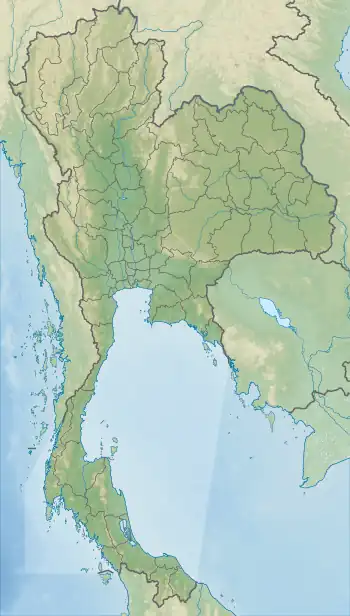| Tham Luang Nang Non | |
|---|---|
| Tham Luang Tham Nam Cham Tham Yai | |
.jpg.webp) Cave entrance in 2018 | |
 | |
| Location | Tham Luang–Khun Nam Nang Non Forest Park, Mae Sai, Chiang Rai Province, Thailand |
| Coordinates | 20°22′54″N 99°52′06″E / 20.38167°N 99.86833°E |
| Depth | 85 metres (279 ft) |
| Length | 10.3 kilometres (6.4 mi) |
| Elevation | 446 metres (1,463 ft) |
| Geology | Karst cave |
| Hazards | Monsoon flooding |
| Access | Tours available (November – April) |
| Lighting | None (before the rescue operation)[1] |
Tham Luang Nang Non (Thai: ถ้ำหลวงนางนอน, lit. 'Great Cave of the Sleeping Lady', pronounced [tʰâm lǔaŋ nāːŋ nɔ̄ːn]) is a karstic cave system in the Tham Luang–Khun Nam Nang Non Forest Park, near the village of Pong Pha, in northern Thailand.[2] It lies beneath Doi Nang Non, a mountain range on the border with Myanmar.
On 2 July 2018, the cave was brought to international prominence when twelve members of a junior association football team and their assistant coach were found deep inside the cave. They had become trapped due to monsoonal flooding on 23 June. A rescue effort succeeded in bringing them out safely by 10 July. Two Thai rescue divers died as a result of the rescue.
Description
The cave is also known as Tham Luang (Thai: ถ้ำหลวง, lit. 'great cave'), Tham Nam Cham (Thai: ถ้ำน้ำจำ, lit. 'Nam Cham cave'), and Tham Yai (Thai: ถ้ำใหญ่, lit. 'big cave').[2] Since tham means 'cave', the commonly used phrase Tham Luang cave is a tautology.
| External images | |
|---|---|
The cave's main entrance chamber is 80 metres (260 ft) long and the complex winds through 10.3 kilometres (6.4 mi) of limestone strata. It has many deep recesses, narrow tunnels, boulder chokes, collapses, and sumps. Stalactites and stalagmites are found throughout the cave.[1] There is a permanent stream inside the cave, which enters from the west, flows with the passage for several metres, and exits via the eastern wall.[2] A team of French cavers made the first survey of Tham Luang's main cave in 1986 and 1987. Further surveys were done in 2014 and 2015 by the British cavers Vern Unsworth, Martin Ellis, Phil Collett, and Rob Harper.[3][4][5]
A visitor centre outside the main entrance has a detailed map of the cave.[2] There is a car park nearby. The first 1 kilometre (0.6 mi) of the cave is open to the public for guided tours between November and April.[1] The cave floods during the rainy season and is closed to visitors.[1]
2018 cave rescue
In 2018, twelve boys aged 11 to 16, all members of a junior association football team, and their 25-year-old male assistant coach were stranded in the cave for 18 days by a flood.[6][7] They were rescued in a massive joint operation between the Thai government, the Thai military, and a group of international expert cave divers.[8] British divers found them on a muddy ledge in darkness more than 4 kilometres (2.5 mi) from the entrance nine days into their ordeal. The effort to save their lives was a global operation watched around the world.[9] In all, 90 divers – 50 of whom were foreigners – helped to extract the group.[10][11] An ex-navy diver, Saman Kunan,[12] died during the mission[13] because he ran out of air, having placed air tanks along the route for the boys.[14] Another diver and ex-Navy Seal died a few months later from an infection he contracted during the cave rescue.
References
- 1 2 3 4 "ถ้ำหลวงขุนน้ำนางนอน - เชียงราย" [Tham Luang Khun Nam Nang Non - Chiang Rai] (in Thai). Office of the Natural Resources and Environmental Policy and Planning (ONEP), Ministry of Natural Resources and Environment of Thailand. Archived from the original on 5 July 2018.
- 1 2 3 4 Ellis, Martin (2018). The Caves of Thailand. Vol. 2. Lulu. pp. 151–152. ISBN 978-0-244-33343-0.
- ↑ "Tham Luang: Tham Nang Non - Tham Lak - Date 2014-03-09". British Cave Registry. Retrieved 11 July 2018.
- ↑ "Tham Luang: Tham Nang Non - Tham Lak - Date 2015-02-28". British Cave Registry. Retrieved 11 July 2018.
- ↑ Ellis, Martin (2015). Thailand's Longest and Deepest Caves: A Caving Guide. ISBN 978-1-326-43857-9.
- ↑ "Cave rescue: Boys and football coach free from Tham Luang". BBC. 10 July 2018. Retrieved 11 July 2018.
- ↑ "All 12 boys and coach successfully rescued from Thai cave". The Guardian. 11 July 2018. Retrieved 11 July 2018.
- ↑ "Cave rescue: The divers who got the Thai boys out". BBC. 11 July 2018. Retrieved 11 July 2018.
- ↑ "Thailand cave rescue: The Brits who helped find the boys". BBC. 3 July 2018. Retrieved 11 July 2018.
- ↑ "The Straits Times". 10 July 2018. Retrieved 11 July 2018.
- ↑ "First 2 boys rescued from Thai cave in daring mission". Free Malaysia Today. 8 July 2018. Retrieved 11 July 2018.
- ↑ "Thai navy Seals pay tribute to diver who died in cave rescue". The Guardian. 6 July 2018. Retrieved 11 July 2018.
- ↑ "Thailand cave rescue: Ex-navy diver dies on oxygen supply mission". BBC. 6 July 2018. Retrieved 11 July 2018.
- ↑ Sai, Mae (6 July 2018). "Thais fight water and oxygen levels in cave as diver dies". ABC News. Retrieved 11 July 2018.
Further reading
- Louis Deharveng; et al. (1988). Expeditions Thai 87 – 88 (PDF). Toulouse: Association Pyrénéenne de Spéléologie. ISBN 2-906273-02-3.
- John Robert Dunkley (1995). The Caves of Thailand. Sydney: Speleological Research Council. ISBN 0-9589253-9-9.
- Martin Ellis (2009). "Thailand's Top Twenty: A Guide to the Longest and Deepest Caves in Thailand". Shepton Mallet Caving Club Journal. 12: 140–232.
- Martin Ellis (2015). Thailand's Longest and Deepest Caves: A Caving Guide. pp. 10–12. ISBN 978-1-326-43857-9.
- Pindar Sidisunthorn; Simon Gardner; Dean Smart (2006). Caves of Northern Thailand. Bangkok: River Books. ISBN 9749863135.